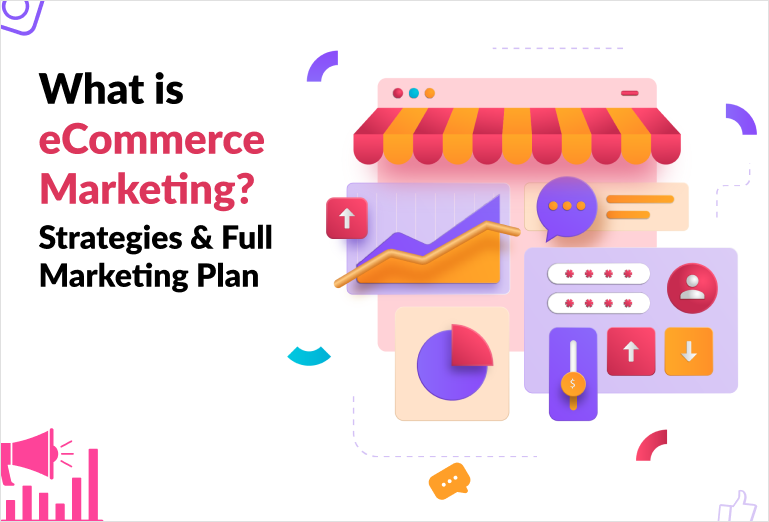WHAT IS E-COMMERCE MARKETING STRATEGIES AND FULL MARKETING PLAN
WHAT IS E-COMMERCE MARKETING STRATEGIES AND FULL MARKETING PLAN

What is eCommerce Marketing? Strategies & Full Marketing Plan
ContentsArrow down
What is eCommerce Marketing?
Types of eCommerce Marketing Ideas
10 of the Best eCommerce Marketing Strategies
How to Write an eCommerce Marketing Plan
The marketing strategies needed to sell in a physical shop are different from what’s needed in an online store. Although physical stores have e-channels that attract online sales, you can’t adopt the same strategies you use to sell in-shop.
Choosing out of eCommerce platforms, building your eCommerce website, and investing in online advertising are the minimum to start an eCommerce business.
If you want to drive online sales consistently, you need to choose and implement the right eCommerce marketing strategy. However, no strategy works in a vacuum. You have to decide which eCommerce marketing tactics to use.
Luckily, we put together a comprehensive guide that shows you how to use eCommerce marketing to build successful online businesses.
What is eCommerce Marketing?
eCommerce marketing is the use of promotional activities to drive traffic to your online store and guide prospects through your sales funnel. This process covers creating awareness about your eCommerce store and converting site visitors into paying customers.
Let’s face the facts. Launching your eCommerce store is no guarantee you will drive traffic and attract sales to your website.
You need a comprehensive eCommerce marketing strategy to grow your online business. People have to first find your eCommerce site before they can decide whether or not to buy from you.
Online retailers use eCommerce marketing campaigns to attract customers (customer acquisition) and turn one-time shoppers into loyal ones (customer retention marketing)
The end goal of every online marketing strategy is to drive eCommerce sales. However, there are other benefits you stand to gain.
Makes your brand, products, and eCommerce website easily discoverable to your target audience.
Drives your website visitors to make another purchase through upsell and downsell tactics and convinces those who abandoned the cart to complete the order.
Improves the on-page, checkout, and post-purchase experience to increase customer satisfaction, retention, and loyalty.
Pro Tip: Your strategy and tactics should include online marketing activities like social media and digital marketing as well as offline ones like TV and print ads.
Types of eCommerce Marketing Ideas
Starting and running a profitable online store requires many steps, like finding the right product niche, reliable product vendors, and eCommerce optimization potentials. However, without the right eCommerce marketing ideas, your online business won’t generate sales.
Let’s check the best online marketing tactics that are popular among eCommerce marketers.
1. Invest in eCommerce SEO
Search engine optimization (SEO) is getting your online store to rank on search engines like Google and Bing to attract organic traffic and more visibility. This eCommerce marketing idea is one of the best free ways to market your online business and products.
A sound eCommerce SEO strategy gets your product pages to rank on the first page of the Search Engine Result Pages (SERP). When you rank among the top ten search results, you stand the best chance of attracting organic search traffic to your website.
For example, if a customer searches for “yoga pants for women” on Google, you want your product page to appear among the top results.
However, getting your product page to fall into the top ten search results for your target keywords is far from easy. SEO statistics show that 90.63% of pages get no organic search traffic from Google, and being in the 9.37% is extremely difficult.
If you are looking for a free or cost-effective traffic source for your online store, eCommerce SEO is ideal.
Best Tips for Investing in eCommerce SEO
Conduct Keyword Research: Use keyword research tools like SEMrush, Google Keyword Planner, and Ahrefs Keyword Explorer to find the best keywords with a high search volume and low competition. Use relevant keywords where possible, such as URLs, product descriptions, and titles.
Optimize Your Website for Mobile Devices: Using a mobile-friendly website matters for SEO. Google and other search engines favor mobile-optimized websites over non-mobile-friendly ones.
Optimize Page Load Time: The secret of customer retention is to keep your current and potential customers happy. When your website takes long to load, you will lose a large chunk of your traffic. Ensure your website’s page load speed is under 3 seconds. You can improve your page load speed by using a fast web host and optimizing images.
Build Backlinks: Get different types of backlinks from reputable websites to boost your domain authority and search rankings. If you want other websites to link to you, simply create content that’s worth it. Reach out to authority sites and ask for a link.
Run an SEO Audit: Struggling to get your website to rank on Google despite following every SEO tip? Perform an SEO audit with tools like Google Search Console, Ubersuggest, and Ahrefs. These tools help you find out what’s preventing your website from ranking. They help fix technical SEO errors like duplicate pages.
Pay Attention to Local SEO: Create your Google My Business profile to give your eCommerce business more visibility for local searches. Strengthen your local SEO game by using local marketing strategies to drive traffic and awareness in your local region.
2. Leverage Email Marketing
Forget the many “email marketing is dead” articles you can find online. The truth is that email marketing remains one of the best ways to promote your eCommerce business.
Email marketing is pound-for-pound the best eCommerce marketing channel that generates the most return on investment (ROI). eCommerce marketing statistics show that for every dollar spent on email marketing, you receive $44 in return.
Out of the different marketing channels available to the eCommerce marketer, email marketing is the cheapest and most reliable option. No company like Amazon, Facebook, or Google can lock you out of your account and cause you to lose your acquired subscribers.
Successful email marketing is one of the best weapons at the eCommerce marketer’s disposal. This eCommerce marketing type helps you promote sales, increase brand awareness, and generate repeat customers.
Email marketers use the best email marketing services to build a responsive email list, send email campaigns, and generate a high ROI.
Best Email Types for Your Email Marketing Campaigns
There are different email types you can use to nurture leads, engage your audience, and convert them into sales.
Welcome Email: The first email a subscriber receives after subscribing to your newsletter.
Drip Nurture Email: A steady flow of email content about your product or brand until the email subscriber is ready to purchase.
Abandoned Cart Email: A reminder email that notifies customers of the items they left unpaid in the shopping cart and encourages them to complete the checkout process.
Post-Purchase Email: The content of this email revolves around building a strong relationship with customers to get them to become repeat buyers.
Upsells and Cross-Sells Emails: These emails attract your current customers with related products to what they purchased.
Win Back Email: An email you send to a subscriber who hasn’t purchased in a long time to try and win them back as active customers.
Loyalty Reward Email: An email that rewards customer loyalty with different incentives such as freebies, discounts, and extra perks.
VIP Offer Email: An email that offers special deals to VIP and loyal customers,
eCommerce Newsletter: An email that provides regular updates about your latest products, discount offers, and your brand.
3. Think about Conversion Rate Optimization (CRO)
Conversion rate optimization (CRO) is the on-site measure that converts as many visitors as possible into buyers. The number one key metric for any eCommerce store is its conversion rate.
eCommerce businesses spend money and vital marketing efforts to get traffic to their website. However, without converting traffic to revenue, there’s no gain.
Practicing CRO helps eCommerce sites to spot leakages in their sales funnels and fix them to convert more traffic into customers.
These questions help you optimize your product pages and websites to drive sales.
Where are you losing sales?
Who are those visiting your website and not purchasing?
Why is your traffic dropping off?
What changes can you make to your product pages and online store to stop leakages in the conversion process?
Best Conversion Rate Optimization (CRO) Tools
There are different conversion rate optimization (CRO) tools designed to improve your eCommerce store’s conversion rate.
Recommendation Engine: Personalizing the shopping experience for each website visitor increases your conversions. Use this marketing tool to recommend products based on your customer’s purchase history.
Cart Abandonment Recovery: Not everyone who visits your product pages and places items in a cart will complete the buying process. The reasons range from loss of interest in your product to different issues at checkout. Use cart abandonment software to send reminder emails to prospects who didn’t complete their purchase.
Lead Generation: They cover marketing tools that help you generate leads. When a prospect visits your website, use opt-in forms and exit intent pop-ups to collect their data.
4. Use SMS Marketing
SMS marketing uses text messages to create brand awareness and promote your products or business. This marketing tactic helps you send text messages to potential and existing customers about your sales promotions and exclusive offers.
People tend to respond faster to text messages than emails. SMS marketing statistics show that the average open rate for email marketing campaigns is 20%, while text message campaigns’ open rate is up to 98%.
Best Tips for Effective SMS Marketing
SMS marketing is one of the best eCommerce marketing channels for creating awareness about your business and driving sales. However, if you are to practice it effectively and get your desired results, you need to follow some guidelines.
Get Your Contacts Permission: Don’t send unsolicited text messages to your target audience. Ask for their permission first to avoid getting your business line reported as spam or blocked. Getting permission from your contacts will increase your SMS open and click-through rates.
Monitor the Timing of Your Messages: Send text messages during active hours when your target audience is likely to open them. Some countries regulate SMS marketing and prohibit you from sending text messages after 10 PM.
Add Your Business Identity in Your Text Messages: When running an SMS marketing campaign, include at least your business name in the text messages you send. Adding this information helps recipients recognize SMS from your brand and prevent them from ignoring or marking them as spam.
5. Invest in Social Media Marketing
eCommerce businesses benefit massively from social media platforms like Twitter, Facebook, TikTok, and Instagram.
Opening a social media page for your eCommerce business is a no-brainer decision for any business owner that wants to maximize their ROI. Social media statistics show that there are over 4.62 billion social media users globally. Facebook alone has 1.96 billion daily active users.
There are two types of social media marketing: organic and paid.
Organic Social Media Marketing
Organic social media marketing refers to marketing activities done on social media platforms without paying for them. Businesses use organic social media marketing to establish their brand’s values and personality, build a following, and engage with customers.
You practice organic social media marketing each time you post on your social media account. Your followers, their connections, and people following the hashtags you use will see the post on their timelines.
Optimizing your social media accounts can help you attract a steady flow of organic traffic to your website. You can share free content about your online store, your products, and any relevant topic that interests your target audience.
Post user-generated content that shows your customers using your eCommerce products to drive more sales to your online store.
Paid Social Media Marketing
If you want to grow your eCommerce business to its maximum potential, organic social reach is not enough.
Paid social media marketing puts your brand in front of your ideal target audience, unlike organic social media marketing, which restricts your reach to your followers.
There are two types of paid social media marketing: paid ads and influencer marketing campaigns.
Paid Advertising: Paid social media advertising involves paying to have your marketing messages reach a specific audience. Social media marketing statistics show that 28% of internet users believe social media ads help them discover new products.
Influencer Marketing Campaigns: You can pay social media influencers to promote your products to their audience. If you want to maximize your influencer marketing campaigns, focus on micro-influencers that align with your brand’s values and have influence over your target audience.
Best Tips for Investing in Social Media Marketing
Grow Your Presence Where Your Target Audience Are: Focus on growing your online presence on the social media platforms that your target audience visits frequently. TikTok and Instagram is the go-to platform for targeting millennials, while Facebook and Twitter is a better fit for targeting older audiences.
Use Social Media Management Tools: With many social media platforms with hundreds of millions of users, managing multiple accounts can be time-consuming and expensive. Use the best social media management tools to manage your social media activities and still have time to handle other areas of your business.
Be Consistent in Your Content Delivery: Posting consistently on your social media accounts increases the likelihood that your customers will view your content. Post daily or a few times a week. You can use social media scheduling tools to plan, manage, and post content consistently on different social media pages.
Provide High-Quality and Valuable Content: If you want your social media accounts to grow and attract traffic to your website, don’t focus excessively on selling. Create high-quality and valuable content relevant to your target audience to gain their trust and build authority in your niche.
6. Run Search Ads
There’s a limit to how much traffic and revenue you can generate with organic means. As your eCommerce business grows, you need to spend on paid search ads to attract quality leads to your website.
Google search statistics show that paid search has a 1% advantage over organic search in generating income.
Paid search advertising displays digital ads in search results when someone searches for the advertiser’s keywords.
Most successful online stores spend massively on paid ads like social media ads and search ads as key aspects of their sales strategies. You can run search ad campaigns to target different stages of the buyer’s journey.
Types of Search Ads
There are different types of search advertising.
Pay-Per-Click (PPC) Campaigns: PPC ads appear at the top of the search engine result page (SERP) ahead of other results. Google Ads dominates the market for PPC ads. These ads target shoppers with a buying intent and lead to a higher conversion rate and sales volume than organic means.
Google Shopping Ads: This search ad type is similar to the PPC ads. With Google Shopping Ads, you can place images of your products, prices, star ratings, titles, and descriptions as part of your ad. This type of search ad is best for eCommerce stores that sell physical products.
Google Local Services Ads: These ads appear at the top of the search engine result page for local searches. Google Local Services Ads connect service businesses to highly-interested leads. Unlike Google Shopping Ads and PPC Ads, you only pay when a lead contacts your business.
7. Start an Affiliate Marketing Program
Affiliate marketing is one of the less risky eCommerce marketing ideas you can try. This eCommerce marketing model involves using a network of affiliates or referrers to drive traffic to your website and improve your sales.
The affiliate marketer and the business owner benefits from the affiliate marketing program. Affiliate marketers get a commission on each sale they generate for the business, while the business owner earns revenue without spending a dime.
Many online articles say affiliate marketing is a declining marketing strategy for eCommerce businesses, especially with the popularity of influencer marketing. The truth is affiliate marketing is a thriving eCommerce marketing tactic if done properly.
Best Tips for Launching an Affiliate Marketing Program
Come Up with a Good Offer: Your offer determines the success of your affiliate marketing program. Before recruiting affiliates, decide the products you want to promote and your sales expectations. A good eCommerce offer contains information about your eCommerce site, the commission rate, product descriptions, and marketing materials.
Research Your Competitors: Identify your top competitors in your niche and monitor how they handle their affiliate marketing program if they have one. Find out their commission rates and their affiliate marketing strategy.
Set Attractive Commission Structures: If you want to attract the best affiliates to promote your products, you need to offer competitive commission rates. Check what other affiliate programs are paying their affiliates and use this information to set your rates.
Recruit Affiliates that Align with Your Niche and Brand: When searching for affiliates, choose those that match your niche and whose content and ideology align with your branding.
Monitor Your Affiliate Offer: Use website analytics tools like Google Analytics to track the impact of your program on your eCommerce site. Track the performance of individual affiliates and your overall affiliate program.
8. Leverage Content Marketing
Content marketing is a popular marketing tactic used by eCommerce businesses to build brand awareness, attract traffic, and close sales. When you create content, it’s evergreen. You can reuse it for other campaigns, such as social media posts and newsletters.
Use content marketing to answer questions raised by your potential customers, educate them about your brand, and help them make informed choices about your products.
There are many content formats eCommerce brands can use, like blog posts, podcasts, videos, and user-generated content (testimonials).
Content marketing provides you with the best opportunity to overcome your prospects’ potential objections. Share high-quality content that tells your story, positions you as an authority in your niche, and convinces potential and current customers to shop with your brand.
SEO is crucial if you want to maximize your content marketing game. Optimize every created content to rank for the search terms your target audience uses.
There are different areas on your eCommerce website where you can use content marketing.
Product Pages: Your headline, product description, high-resolution images, and videos are content.
Blog Section: Set up a blog for your online store and start creating content that provides real value to your prospects and customers. Examples of blog content include blog posts, checklists, infographics, and downloads.
Media: You can create interactive media content and provide high-quality video demonstrations of your products.
Best Tips for Leveraging Content Marketing
Leverage SEO: Search engine optimization (SEO) can boost your content marketing game. When a prospect searches for your product, you want Google to show your product page on the first page of the search engine result page (SERP). Optimizing your online store for SEO can help you achieve such a goal.
Create a Blog: A blog is a must-have for every online store. It presents the perfect opportunity for you to connect with customers, increase your domain name authority, and rank high in search engine results. Create blog posts regularly in the form of long-form content and guides that provide helpful information for your audience.
Start a Podcast: Boost your content marketing campaign by starting a podcast to show your expertise and create a strong community. Don’t just center your podcast on your products. Instead, provide valuable content that appeals to your target audience.
9. Start a Customer Loyalty and Referral Program
Customers are the lifeblood of any eCommerce business. Focusing on customer retention lowers your customer acquisition costs (CAC) and increases your customer lifetime value (CLV).
Online retail statistics show that retaining customers is 5-25x cheaper than acquiring customers. One of the best ways to retain customers is to reward loyal customers with incentives.
Setting up a customer loyalty program makes customers feel more valued and tells them your brand has their best interests at heart. Create different systems for rewarding customers that give them access to discounts, free shipping, coupons, and other enticing rewards.
Create a customer referral program to encourage existing customers to advertise your product for you. There’s no better marketer for your brand than your customers who use your products. Offer profit-sharing rewards and discounts for every paying customer added to your customer base.
Best Tips for Launching a Customer Loyalty and Referral Program
Put Your Customers First: Your customer loyalty and referral program will only thrive when you prioritize your customers’ needs. Take time to communicate and build relationships with your existing customers. The information you get from these conversations will help you build a successful customer loyalty and referral program.
Optimize Your Program for Mobiles: Ensure your customer referral program is mobile-friendly so your customers can easily share it with others via their phones. Keep the process simple and limited to a few steps.
Follow Up On Your Referrals Quickly: Once a customer brings a prospect, don’t delay in reaching out to them. The faster you make an impression on a prospect, the higher your chances of getting them to make a purchase.
Diversify Your Rewards: Give your customers the option to pick from a pool of rewards. Some reward ideas you can try out include free shipping and cashback rewards. You can offer other options like donating their loyalty and referral points to charity.
10 of the Best eCommerce Marketing Strategies
The right eCommerce strategy attracts a truckload of traffic to your site, increases sales, and improves your customer lifetime value (CLV).
The eCommerce industry has multiple business models, niches, and target groups, which makes it impossible to pick a one-size-fits-all strategy.
The fact that one eCommerce marketing strategy works for your brand doesn’t mean it will work for another. However, there are global tips that can guide you in developing the perfect eCommerce marketing strategy for your brand.
1. Define Your Target Audience and Market
Who is your target audience? Do you understand your target market? Before you develop any eCommerce marketing strategy, know your target market and audience.
Without this information, it’s difficult to create the right offer, use the best channels, send the right messaging, and identify the best audience for your products or brand.
2. Check Your Competitors
What eCommerce strategy and tactics are your competitors using? You don’t always need to invent your eCommerce strategy. Check what your competitors are doing and adopt strategies that work.
Analyze their marketing tactics and strategies to see what you can improve on. You can find marketing channels and an underserved target market you can focus on to gain a competitive advantage.
3. Set Targets Based on Benchmarks
What are your sales expectations? Before you set your sales expectations, you need to know what’s possible in your niche.
As a new eCommerce business owner without any reliable data of your own to check, you have to rely on external data. Use industry benchmarks to create your sales projections.
4. Research Helpful Marketing Tools
What marketing tools can help you achieve your sales goals? Creating and running your eCommerce marketing strategies can be overwhelming. There are many marketing tools you can use to improve your productivity and increase your results.
Marketing automation tools help you automate every aspect of your eCommerce business to increase revenue and productivity.
Mass email services and email newsletter software help you send bulk emails and newsletters to your subscribers and drive more leads to your website.
Autoresponder software helps you run your email marketing campaigns and convert leads into paying customers.
5. Use Marketing Channels that Connect You to Your Audience
Where can you find your target audience in large numbers? Invest more time and resources in marketing channels that put you in front of your ideal audience.
If you are new to selling online, don’t make the mistake of using every marketing channel you can find on Google. Select only a few you can focus on, and then as your business grows, you can expand to other channels.
6. Automate As Much As Possible
What eCommerce tasks can you automate? If you want to scale your eCommerce business to its maximum, you need to set up an autopilot system for your tasks.
Marketing automation tactics like automated workflows, bulk emails, notifications, and lead scoring help you manage your day-to-day business processes.
7. Personalize Your Communication
What are the best communication channels for your target market? Emails, SMS, and live chat are some of the common communication channels used by eCommerce businesses to communicate with their audience.
Irrespective of the communication channel you use, you will get better results when you send personalized and relevant messages instead of generic ones.
Your prospects and customers will respond better when you mention their names and address their specific needs in your communications.
8. Track Your eCommerce Marketing Results
How do you measure the success of your eCommerce marketing efforts? What are the marketing KPIs you should be tracking? The easiest way to track the effectiveness of your eCommerce marketing strategy is to track the ROI.
Any marketing campaign that doesn’t generate a positive ROI is not helping you increase sales. You don’t have to discard the marketing campaign instantly. Analyze it to find out what works and refine it to increase the ROI.
Optimize your eCommerce marketing strategies that work and invest more money in them to enjoy better sales results and profits.
9. Build Customer Loyalty into Your Strategy
Does your eCommerce strategy turn prospects into loyal customers? Customer loyalty is essential for the growth of any business. Having loyal customers boosts your profits. They are your number one marketer that refers new customers to your store.
10. Prioritize Profitability over Sales
What are your customer acquisition costs? Do you spend more acquiring customers compared to the revenue they bring? The more you pay to acquire new customers, the less profit you have, especially when they are mostly one-time customers.
Every eCommerce store finds it easier and cheaper to drive repeat sales from current customers than from new ones. Focus more on attracting repeat customers to increase your profit margins.
How to Write an eCommerce Marketing Plan
Before you implement your marketing strategy for your online store, create an eCommerce marketing plan to guide your steps.
An eCommerce marketing plan is the road map you follow to achieve your marketing and sales goals. Keep your eCommerce marketing plan simple and relevant to your brand. Only pick marketing strategies and tactics you can conveniently use.
Here’s a detailed breakdown of an eCommerce marketing plan for an online fashion store.
Step 1: Run a social media campaign on TikTok to build awareness and drive traffic to the online fashion store.
Step 2: Set retargeting TikTok Ads to convert your store visitors into paying customers.
Step 3: Send traffic to a custom landing page where you get your leads to subscribe to your email newsletter.
Step 4: Use email marketing software to create an automated email sequence to send letters at intervals to your subscribers. The first email in the sequence is the welcome email. Send email newsletters about your products and brand to keep your subscribers engaged.
Step 5: Work with TikTok influencers to generate more leads for your eCommerce business.
Step 6: Create an eCommerce SEO strategy to generate organic traffic from search engines.
Step 7: Run paid search ads like pay-per-click ads and Google Shopping ads to reach your target group.
Step 8: Create special sales offers on important eCommerce promotion days like Black Friday, Christmas, and Valentine’s Day to attract more sales.
Step 9: Create a customer loyalty program to reward your loyal customers and a customer referral program to attract new ones.
Step 10: Test other eCommerce marketing ideas like content marketing, affiliate marketing, and SMS marketing. Reuse the ideas that work and discard the ones that don’t.
Do you find 9jahitsongs useful? Click here to give us five stars rating!












![[BLAQBONEZ LIKE ICE SPICE LYRICS]](https://9jahitsongs.com/wp-content/uploads/2023/08/67BECD45-0122-4AA5-94BD-6E5DE3C87001.jpeg)
![[OLIVETHEBOY GOODSIN LYRICS]](https://9jahitsongs.com/wp-content/uploads/2023/08/CBAEAB69-3057-4E3D-A3CF-98B0E3D8F164.jpeg)


